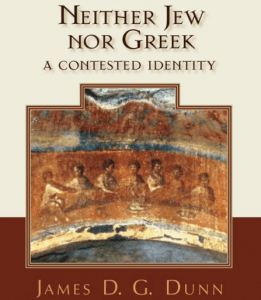 Here is the question Professor James D.G. Dunn asks in his lengthy chp (Neither Jew Nor Greek) on the Jesus tradition in the 2d Century AD:
Here is the question Professor James D.G. Dunn asks in his lengthy chp (Neither Jew Nor Greek) on the Jesus tradition in the 2d Century AD:
In particular, should the NT Gospels be regarded as the only true inheritors of the oral Jesus tradition, the only authoritative written expressions of the Jesus tradition? (406)
If you check out the bookshelves in bookstores, or read what is happening every year around Easter (though this year was mild), or think of Bart Ehrman or Dan Brown, you would think the answer to the question was No, No, No, and No because there was a massive diversity that was shunted and narrowed down to a diversity-degrading uniformity, conformity, coerciveness and false unity with the rise of the Nicene Creed and orthodox Christianity. Well, Dunn doesn’t play Ehrman’s game of conspiracy, for which he has become famous, but instead plays the game of evidence — fair and honest. Nor does Dunn play the game of “whatever the creedal tradition teaches us is all we need to believe.” He’s fair and honest.
We are treated to a patient investigation of the identity that was contested so virulently in the 2d Century. Here are some conclusions:
- With one or two exceptions, the Jesus tradition, particularly the sayings of Jesus, was often cited and constituted an important element in catechetical and paraenetic teaching.
- This was true across quite a wide spectrum of churches as attested by the documents reviewed.
- Some of the use of the Jesus tradition is explicitly attributed to ‘the Lord’. But much more seems to have simply been absorbed into the lifeblood of these early churches.
- While several features within the echoed Jesus tradition can be linked to distinctive features of one of the already written Gospels, particularly Matthew, but also John, the references do not demand to be interpreted as quotations or dependent on the writers having a written Gospel to hand.
- The Papias testimony in particular confirms that oral Jesus tradition was still a lively resource for the early churches. (449-450).
What of the 2d Century apologists? (Aristides, Justin Martyr, Tatian, Athenagoras, Theophilus of Antioch, and Melito of Sardis, here including Irenaeus, but leaving to one side the Epistle to Diognetus)
What is particularly interesting in comparing the testimony drawn from the Apostolic Fathers with the testimony of the apologists is the transition from a knowledge of the Jesus tradition primarily in oral terms (through regular liturgical and catechetical usage) to a greater awareness of and reliance on written Gospels. Also evident is little or no use of or reliance on the sort of tradition attributed to Jesus by the Gospel of Thomas and the apocryphal Gospels to be reviewed below — even though catechetical and apologetic presentations did not hesitate to elaborate the Christian teaching and claims by drawing on other sources. Together these facts strongly suggest: (1) that the oral Jesus tradition was steadily being conformed to the written versions in the NT Gospels — the NT Gospels were well on the way to providing the main body of Christians with the norm for what counted as Gospel; and (2) that the inscribing of the Jesus tradition was seen as a way of bracketing it off from the other Gospels which were beginning to appear in this period a way of preventing the Jesus tradition from being elaborated in ways which drew it too far away from its original inspiration in the life, teaching, death and resurrection of Jesus (462).
Another patient discussion of the Gnostic Gospels, leading to this:
In sum, the Gnostic Gospels show awareness of and reliance on the Jesus tradition as known to us from the NT Gospels, but provide no evidence of Jesus tradition which might have been known to but unused by the NT Gospel writers. They provide evidence only of Jesus tradition elaborated and adapted to fit with anthropological and soteriological claims, which, as with the Gospel of Thomas, had been drawn from a different perception of the human condition. Not least of interest are the number of indications that some groups saw in the special relationship between Jesus and Mary Magdalene opportunity to contest the patriarchal leadership of the great church (488).
Here are Dunn’s major conclusions of this lengthy chp on the Jesus tradition in the 2d Century:
- It is very likely that the Jesus tradition continued to be known orally well into the second century.
- There is sufficient indication that the inscribing of the Jesus tradition by Matthew and John in particular influenced the wider (oral) Jesus tradition, so that often the echo of or allusion to Jesus tradition, or the more widespread catechetical, liturgical and apologetic tradition, would bear the stamp of features introduced to the Jesus tradition by the versions which Matthew and John recorded.
- As the second century progressed, it would appear that dependency on the oral tradition as such diminished as the NT Gospels became more widely known and influential.
- The other (non-canonical) Gospels also attest the influence of the first-century Jesus tradition. But characteristically the more gnostically oriented Gospels weave earlier Jesus tradition into a diagnosis and narrative of the human condition which is not drawn from the earlier Jesus tradition but from elsewhere.
- It is wholly understandable, therefore, that Irenaeus should see in the four NT Gospels both the foundation documents for Christianity and the bulwark against the distortions and perversions of the gospel content and format which were the other Gospels. In this Irenaeus was not taking an unusual step, or trying single-handedly to withstand a torrent of other Gospels causing confusion among the mainstream of Christians. He was simply summing up the trends that had always been there, from the late first century, and bringing to appropriate conclusion what had been the main thrust of the Jesus tradition into the second century (503-504).











